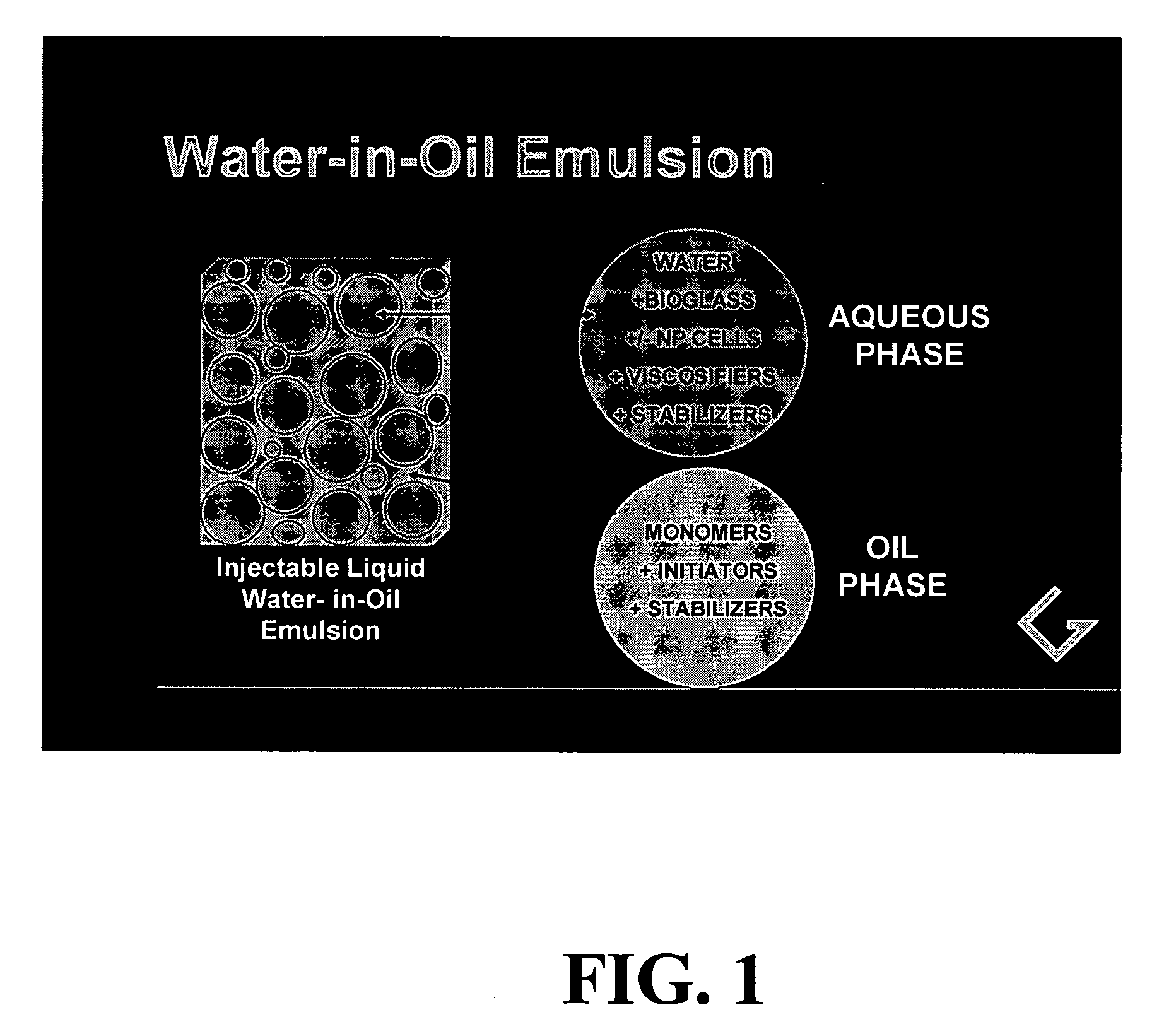Polymerizable emulsions for tissue engineering
a polymerization and tissue technology, applied in the direction of prosthesis, impression caps, applications, etc., can solve the problems of degeneration and water loss at the rupture, total elimination of motion at the fused joint, and more vulnerable spines to trauma and degenerative spondylolisthesis and increasing pain, so as to improve the performance, stability and durability of the produ
- Summary
- Abstract
- Description
- Claims
- Application Information
AI Technical Summary
Benefits of technology
Problems solved by technology
Method used
Image
Examples
example 1
Preparation of the Basic Emulsion
[0083] In this experiment, the simplest water-in-oil (W / O) emulsion was prepared that can provide a photoinitiated, cured two-phase polymerization product. The liquid emulsion was prepared from a single organic acrylate monomer, lauryl acrylate, which was selected specifically to form a biocompatible polymer with significant viscoelastic properties. The ratio of aqueous (water-containing) phase to organic phase was chosen as 30% to represent a range of possible ratios that would provide a stable emulsion with sufficient and substantial (non-trivial amounts of) aqueous phase to enable the presence of bioactive materials or cells, if they are added.
[0084] W / O emulsion “A” was prepared by combining: [0085] i. 101.8 g lauryl acrylate monomer (CPS Ageflex FA12P) was combined with 1.84 g BAPO photoinitiator (BAPO: bisacyl phosphine oxide) (Ciba Irgacure 819) from Ciba Specialty Chemicals, Tarrytown N.Y.; then [0086] ii. 2.03 g PE-PEO surfactant (block co...
example 2
Addition of Bioactive Glass to the Basic Emulsion
[0090] The simple monomer and photoinitiator system of Example 1 was extended to include a bioactive glass material known to promote cell growth, see references above. This experiment was conducted to demonstrate that an aqueous dispersion of important biological components could be introduced. in the liquid state and incorporated by photopolymerization into a stable 2-phase solidified polymerization product.
[0091] W / O emulsion “B” was prepared by combining: [0092] i. 50.1 g CPS Ageflex FA12P lauryl acrylate monomer was combined with 0.89 g Irgacure 819; then [0093] ii. 0.53 g PE-PEO surfactant, HLB 4.0 was added to 28.7 g of blend prepared in step (i) to form an organic (Oil) phase; then [0094] iii. 1.0 g bioactive glass ceramic (MO-SCI Corp., Rolla, Mo.) and 1.0 g corn starch (Argo) was combined with 100.1 g buffered saline solution and agitated to form aqueous (Water) phase dispersion; then [0095] iv. 10.2 g aqueous dispersion wa...
example 3
Emulsion System Using Alternative Dispersant
[0098] Further extending the information provided in Examples 1 and 2 about the nature and capabilities of the emulsion system, a second dispersing agent, calcium stearate, was added to show that the invention is not limited to a single dispersant, the PE-PEO (diblock copolymer of polyethylene and polyethylene oxide) of Examples 1 and 2. In fact, the emulsion formed in Example 3 was otherwise found to be identical to that of Example 2. It is also photopolymerized successfully, although a difference was observed. The aqueous phase droplets in the emulsion of this Example 3 are of larger size than those of Example 2, demonstrating the different surfactants have different effects on the dispersed aqueous phase droplet sizes.
[0099] W / O emulsion “C” was prepared by combining: [0100] i. 50.1 g CPS Ageflex FA12P lauryl acrylate monomer was combined, as above, with 1.01 g Irgacure 819; then [0101] ii. 1.06 g calcium stearate was added to the com...
PUM
| Property | Measurement | Unit |
|---|---|---|
| water content | aaaaa | aaaaa |
| pressures | aaaaa | aaaaa |
| droplet size | aaaaa | aaaaa |
Abstract
Description
Claims
Application Information
 Login to View More
Login to View More - R&D
- Intellectual Property
- Life Sciences
- Materials
- Tech Scout
- Unparalleled Data Quality
- Higher Quality Content
- 60% Fewer Hallucinations
Browse by: Latest US Patents, China's latest patents, Technical Efficacy Thesaurus, Application Domain, Technology Topic, Popular Technical Reports.
© 2025 PatSnap. All rights reserved.Legal|Privacy policy|Modern Slavery Act Transparency Statement|Sitemap|About US| Contact US: help@patsnap.com


